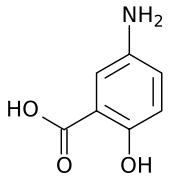Mesalazine
 | |
| Clinical data | |
|---|---|
| Trade names | Many names worldwide, including Asacol, Lialda, Pentasa, and Apriso[1] |
| AHFS/Drugs.com | Monograph |
| MedlinePlus | a688021 |
| License data |
|
| Pregnancy category |
|
| Routes of administration | oral, rectal |
| ATC code | |
| Legal status | |
| Legal status |
|
| Pharmacokinetic data | |
| Bioavailability |
orally: 20–30% absorbed rectally: 10–35% |
| Metabolism | Rapidly & extensively metabolised intestinal mucosal wall and the liver |
| Elimination half-life |
5 hours after initial dose. At steady state 7 hours |
| Identifiers | |
| |
| CAS Number | |
| PubChem CID | |
| IUPHAR/BPS | |
| DrugBank | |
| ChemSpider | |
| UNII | |
| KEGG | |
| ChEBI | |
| ChEMBL | |
| ECHA InfoCard |
100.001.745 |
| Chemical and physical data | |
| Formula | C7H7NO3 |
| Molar mass | 153.135 g/mol |
| 3D model (JSmol) | |
| |
| |
| (verify) | |
Mesalazine, also known as mesalamine or 5-aminosalicylic acid (5-ASA), is an aminosalicylate anti-inflammatory drug[2] used to treat inflammatory bowel disease, including ulcerative colitis,[3][4][5] or inflamed anus or rectum,[6] and to maintain remission in Crohn's disease.[3][7]
It is sold in an oral form to maintain remission in Crohn's disease,[3] and as a rectal suppository[4][6] and an enema for the lower bowel conditions.[5] It is generic and sold under many brand names worldwide,[1] and there are many formulations.[8]
There are no data on use in pregnant women, but the drug does cross the placenta and is excreted in breast milk. The drug should not be used in children under two, people with kidney disease, or people who are allergic to aspirin.[4]
Side effects are primarily gastrointestinal but may also include headache; GI effects include nausea, diarrhea and abdominal pain. There have been scattered reports of various problems when the oral form is used, including:problems caused by myelosuppression (leukopenia, neutropenia, agranulocytosis, aplastic anaemia, and thrombocytopenia), as well as hair loss, peripheral neuropathy, pancreatitis, liver problems, myocarditis and pericarditis, allergic and fibrotic lung reactions, lupus erythematosus-like reactions and rash (including urticaria), drug fever, interstitial nephritis and nephrotic syndrome, usually reversible on withdrawal. Very rarely, use of mesalazine has been associated with an exacerbation of the symptoms of colitis, Stevens Johnson syndrome and erythema multiforme.[3][4]
Mesalazine is the active moiety of sulfasalazine, which is metabolized to sulfapyridine and mesalazine.[9] It is also the active component of the prodrug balsalazide along with the inert carrier molecule 4-aminobenzoyl-beta-alanine.[10]
References
- 1 2 Drugs.com International trade names for mesalazine April 20, 2016
- ↑ "mesalazine". PharmGKB.
- 1 2 3 4 UK Electronic Medicines Compendium UL Oral Label Last revised December 2015
- 1 2 3 4 UK Electronic Medicines Compendium Suppository Label Last revised February 2016
- 1 2 UK Electronic Medicines Compendium UK Enema Label Last revised January 2016
- 1 2 FDA. US Suppository Label Last updated Nov 2015
- ↑ Sandborn WJ, Feagan BG, Lichtenstein GR (October 2007). "Medical management of mild to moderate Crohn's disease: evidence-based treatment algorithms for induction and maintenance of remission". Alimentary Pharmacology & Therapeutics. 26 (7): 987–1003. doi:10.1111/j.1365-2036.2007.03455.x. PMID 17877506. Retrieved 2009-12-20.
- ↑ Ye B, van Langenberg DR. Mesalazine preparations for the treatment of ulcerative colitis: Are all created equal? World J Gastrointest Pharmacol Ther. 2015 Nov 6;6(4):137-44. PMID 26558148 PMC 4635154
- ↑ Lippencott's Illustrated Reviews: Pharmacology, 4th Ed. Finkel, Cubeddu and Clark
- ↑ Drugs & Therapy Properties 2003 Oct; Vol 19, No. 10